December 2023
Significant Weather Events:

As 2023 draws to a close the southern region has entered into both meteorological and astronomical winter, where the effects of a strong El Niño are becoming evident. As explained in detail in the 10/8/23 - 10/14/23 Weekly summary, El Niño brings higher chances for precipitation during the cool season in the Southeastern United States. This resulted in several storm systems tracking across the region this December. One particularly strong system swept into the region during the beginning of the month and brought with it heavy rainfall and severe thunderstorms. Some storm reports out of this system include golf ball-sized hail in Labadieville, LA, a brief EF-0 tornado in Poplarville, MS, and on the 1st near Deatonville, LA 7.7 inches of rainfall was reported via a CoCoRaHS submission. The most notable, though, was a storm system that tracked through the eastern half of the region on December 9th. This system brought tornadoes, strong winds, and hail primarily to Louisiana, Mississippi, Alabama, Tennessee, and Kentucky. On this day the infamous Clarksville, TN EF-3 tornado tracked for 43 miles northeast into Kentucky. As a result of the powerful tornado, 62 people were injured and 3 were killed. Damage was extensive, in Montgomery County, TN alone it destroyed 114 homes and damaged another 857 according to Montgomery County Emergency Management.
Oklahoma farmers in 2023 had a tough time with drought and a transitioning ENSO phase as we started out the year in La Niña, were in an ENSO neutral phase for some months, and finished the second half of the year in El Niño conditions. Despite this, the state's wheat crop had better than expected results due to precipitation around harvest, during the summer months, according to Oklahoma State's University Extension. Production was still below average though, with production yields depending on the location of wetter conditions. Overall producers had a tough time dealing with long-term drought. These challenges were not seen evenly across all products. For example, soybeans had a relatively low yield while corn had above average yields. Louisiana farmers were also heavily impacted by drought this year, according to estimates by the Louisiana State University AgCenter Louisiana agriculture and forestry suffered $1.69 billion in damages due to the summer's drought and excessive heat. Soybean and sugarcane crops took the hardest hit, where many crops performed poorly or died. Farmers are looking to 2024 with a strong El Niño optimistic as they hope it will make up for this summer's shortcomings.
Temperature:
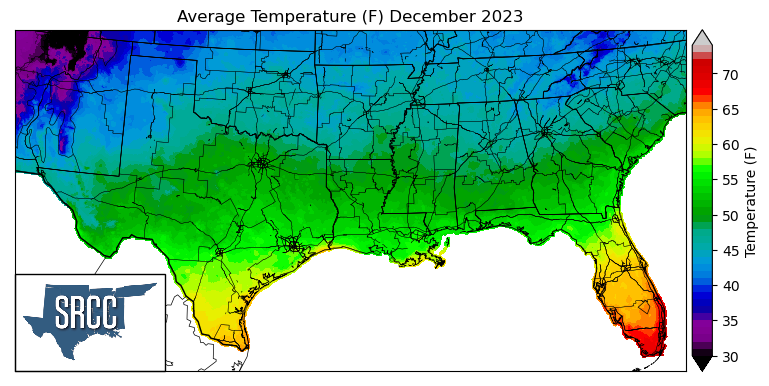
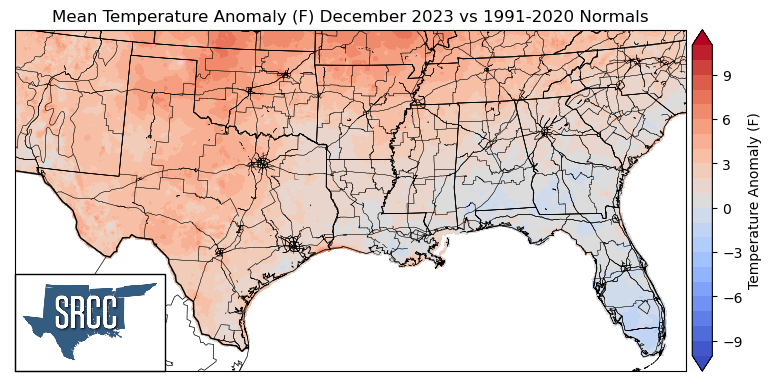
Temperatures were above normal for the entirety of the southern region for the month of December. Overall, the higher the latitude the greater the temperature varied from normal. The largest departures from normal were observed in Northwest Oklahoma averaging 5 degrees Fahrenheit above normal for December, due to large-scale upper-level ridging for a large portion of the month. The southern region began the month with abnormally cool temperatures as a cold front from the end of November left things quite cool and dry. Then things started to warm up and many stations across the region experienced record high temperatures. Where between the 8th and 9th fifteen stations in Texas set a record high temperature. The following week temperatures remained closer to normal due to a strong cold front at the end of the week prior. But, into the end of the month temperatures leading up to Christmas were well above normal until Santa brought with him a cold front to the southern region, bringing rain and cooler temperatures to finish out the month. The result was daily average temperatures for the southern region ranging between 58 and 44 degrees in most places. Some of the coldest daily average temperatures were found in the Great Smoky Mountains of Eastern Tennessee and the Oklahoma Panhandle, where monthly average temperatures were as low as 40 degrees Fahrenheit.
Precipitation:
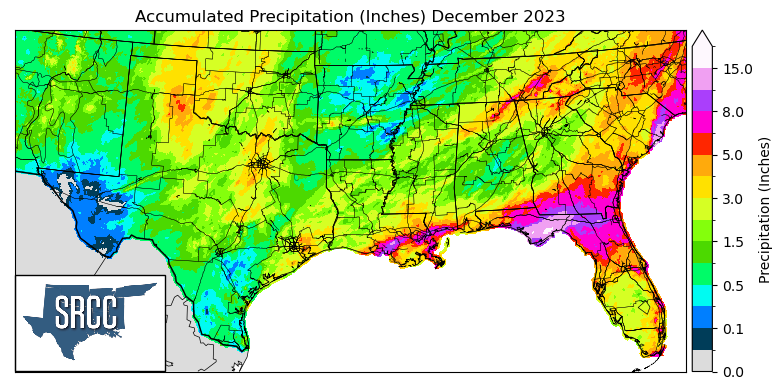
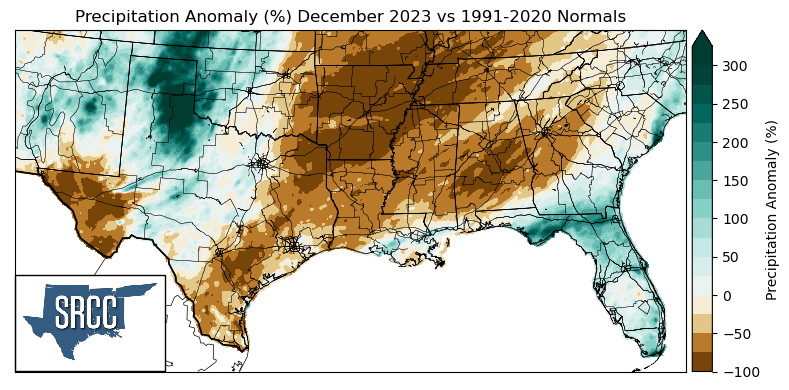
During December the southern climate region saw varying amounts of precipitation. The Northwestern portion of the region received above-normal amounts as well as a small portion of Southeastern Louisiana, where drought is some of the worst in the region. Central Texas was able to see near-normal amounts of precipitation for the month as it received moderate rainfall totals. The largest negative departures from normal were seen in areas of Far West Texas and Arkansas where precipitation anomalies were -100%. The greatest positive anomalies were observed in the Texas and Oklahoma Panhandles, where precipitation accumulations were about two times normal. This is mostly thanks to a warm front turned stationary front that moved northward through the region and then sat there producing several days of above-normal rainfall. Areas in Hall County, TX saw monthly accumulations as high as 6 inches. However, higher monthly accumulations were observed in Southeastern Louisiana, where a squall line at the beginning of the month brought flash floods to Southern Louisiana and Mississippi. On December 1st, in Southeastern Louisiana along the Mississippi border up to 9 inches of rain fell just in 24 hours and for December the region saw an average of 8 inches, helping to improve drought in the region. Rainfall was relatively widespread throughout the region during December as expected during a strong El Niño as the region enters the cool season.
Drought:
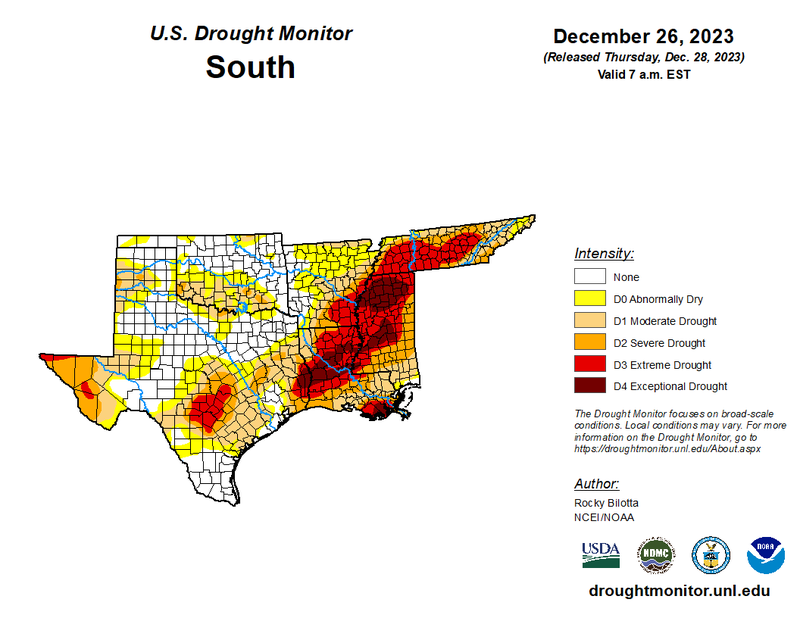
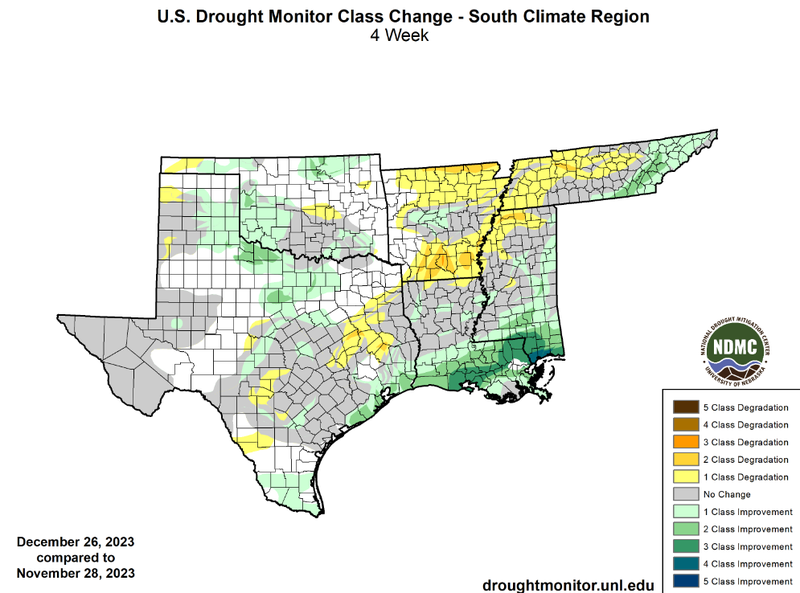
In the beginning of December rainfall was concentrated where it was needed most, in Louisiana, Mississippi, and Tennessee. While the rest of the month only light weekly rainfall accumulations followed. Fortunately, heavy rainfall along the Gulf Coast toward the beginning of the month in Southern Louisiana and Southern Mississippi was enough for widespread two-class drought improvements, with embedded three and even four-class improvements in Hancock and Harrison Counties of Mississippi. Drought improvements were also seen in the Great Smoky Mountains of Eastern Tennessee, North-Central Texas, South Texas, and Western Oklahoma. Unfortunately, though, some areas of the climate region experienced precipitation totals for the month well below normal, leading to developing and worsening drought conditions in East Texas, Northern Arkansas, Southern Arkansas, Northern Mississippi, and West/Central Tennessee. Thankfully, large-scale improvements in Southern Louisiana and Mississippi were able to finally elevate the solid swath of exceptional drought (D4) that plagued the region. From August 29th, 2023 to November 28th, 2023, Southwestern Louisiana has been experiencing exceptional drought (D4) until the beginning of December that improved to extreme drought (D3), and as of December 14th severe drought (D2). However, for drought removal in the driest areas of Louisiana, such as Central Louisiana, about 18 inches of rain is still required. At a regional level, although degradations were observed, vast improvements led to a slight decrease in drought coverage at a regional level. This can be seen by looking at the cumulative percent area of the southern region experiencing D1-D4 drought coverage. At the end of November, 72% of the region was experiencing D1-D4 drought conditions, versus 70.5% by the end of the month. Drought severity also decreased, but significantly from, 10% of the region experiencing exceptional drought (D4) at the end of November, with that number dropping to 5% by the end of December. The last time the southern region saw exceptional drought near this level was August 22nd.
According to the U.S. Monthly Drought Outlook for January, drought is expected to persist in much of the region, in West Texas, Central Texas, Southern Oklahoma, and Tennessee. Areas where drought is expected to remain yet improve are throughout much of Louisiana, Southeast Arkansas, and Mississippi. Drought removal is likely in areas of East Texas, Southern Louisiana, and Southern Mississippi as a strong El Niño is forecasted to bring chances of rainfall well above normal to the Gulf Coast.
